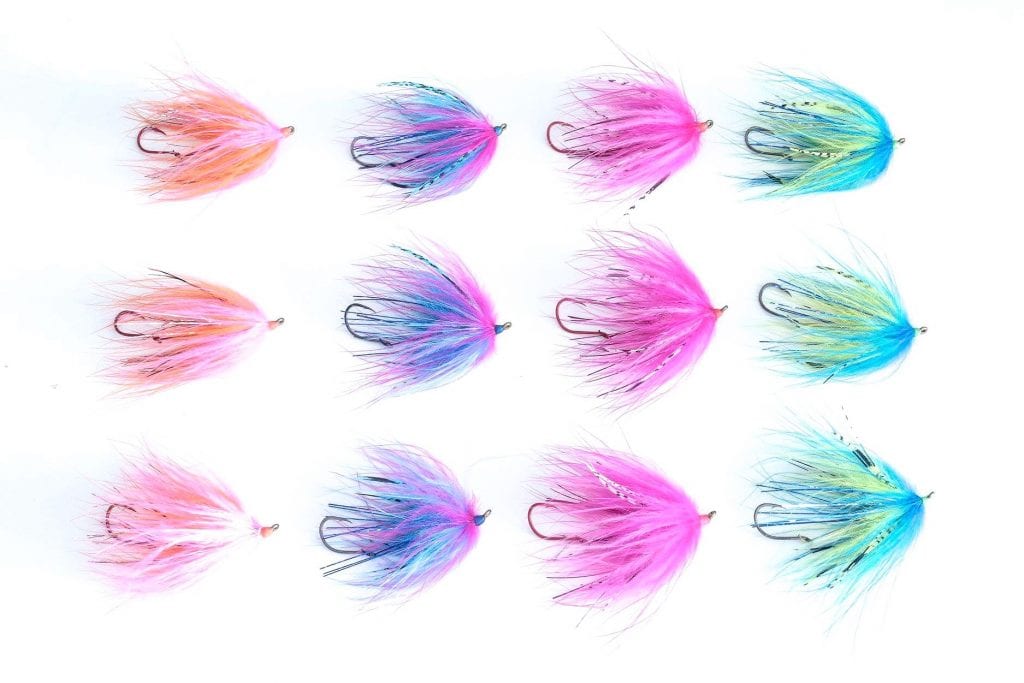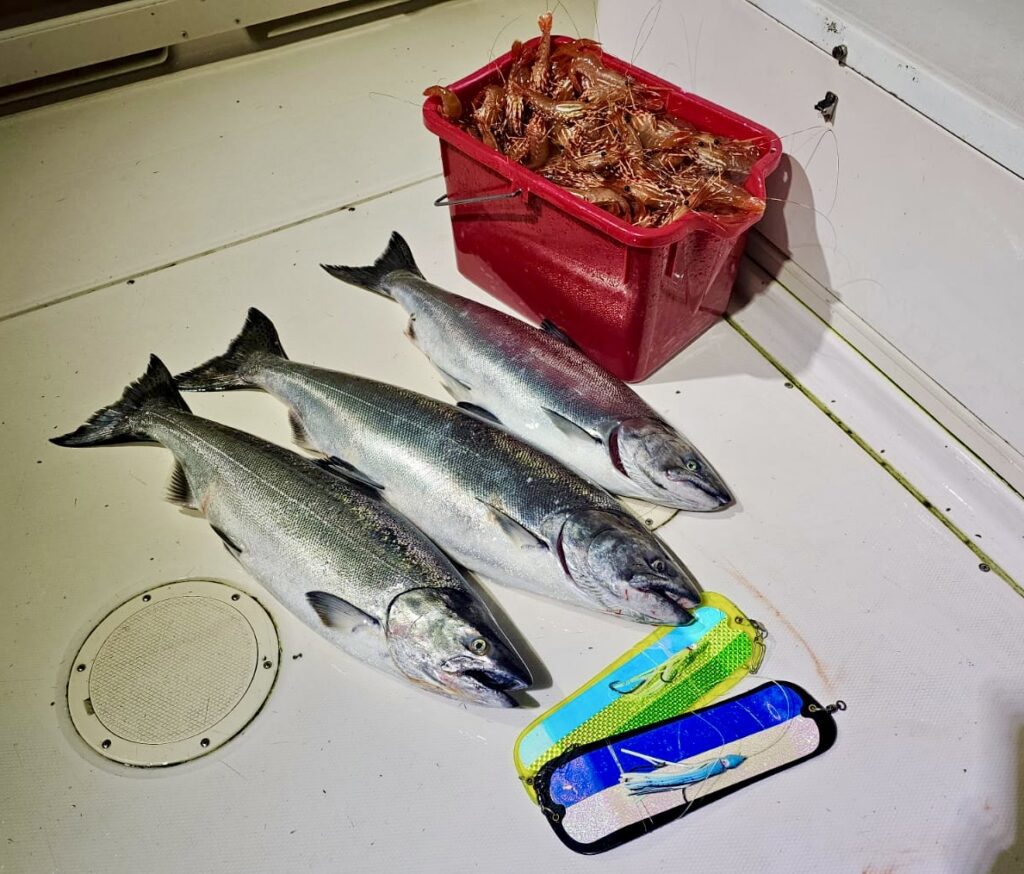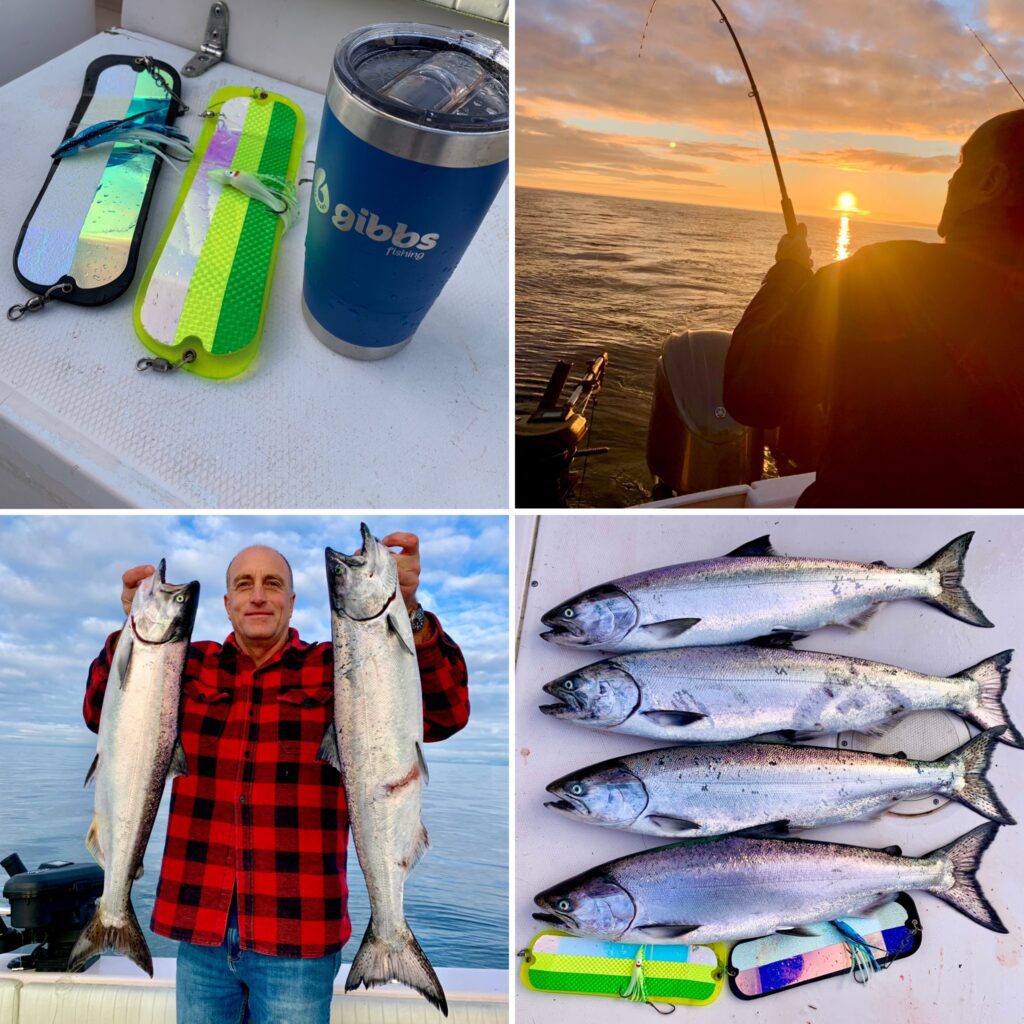OUTLOOK
Happy New Year everyone! The good winter fishing weather continues! We need to define this a little. You may be scratching your head at this statement if you are looking out the window at drizzly less than pleasant weather. For winter fishing weather we want to see reasonably warm temperatures with waves of wet weather to keep river levels fluctuating up and down in a controlled fashion. Last week we got a fair amount of rain. Rivers rose and we did see some dirty water, but the rivers came back into shape fast and held at nice steelhead green colours.
It looks as though we will see similar conditions this weekend. Today as you read the report, we have a large dump of water heading for Squamish as well as a medium dump heading for Chilliwack. This rain is followed by cooler sunny weather Saturday and Sunday and then another round of rain on Monday as the forecast stands right now. Both rivers have been dropping the last couple days so though water levels may be high Saturday and we expect them to be fishing well soon after. We see a similar trend into next week with more rain but again, if the numbers forecast come, it should make for good moving fish conditions. Things look to get MUCH colder heading into next weekend so we will chat more about how to approach fishing in colder conditions in next week’s report.
This week, we have reports on the Squamish River and the Chilliwack River. We also have a steelhead fly fishing primer. Though we always recommend the fly anglers focus more on the middle and back end of steelhead season, (Feb-April) we have heard of a couple on the swung fly this season already and it is worth thinking about.
Finally, though the rain is less than ideal for being out in the boat saltwater fishing we do have a report from Jason. He was out early this week and had some excellent fishing so If you are debating a trip check out Jason’s update at the end of the report.
COURSES
We are looking forward to getting back in the classroom and on the water with you in 2024!
Steelhead Float Fishing Seminar:
January 16, 2024, 6:30PM-9:30PM
$75+GST
Fly Fishing Egg Patterns Seminar and Guided Day on The Water:
Seminar January 17, 2024 – 6:30PM-9:30PM
Guided January 20 or 21, 2024 – Full Day
Seminar Only Cost – $75+GST
Seminar + Guided Day on the water – $325+GST
Tying Intruder Patterns
In this one night course you will learn about the specifics techniques and unique materials used to tie Intruder style flies. At the end of this course you will have the skills needed to tie a variety of Intruder style flies from multi stage, monster flies for high water, average sized flies for everyday conditions, down to small, mini intruders for low water. Note that this course is suitable for intermediate to advanced tiers. Students are required to supply their own vise, tools and materials. A 10% discount is available on materials and tools purchased for the course. A detailed list of what materials are needed will be supplied in advance of the course.
Date: Feb 7, 2024
Cost: $75.00+GST
Time: 6:30pm – 9:30pm

Tying Essential Steelhead Patterns
This course is designed for the fly tyer looking to get the best start on tying steelhead patterns. In the 3-hour evening seminar your instructor will cover everything from tying techniques, material and colour choices, size and weight. They will walk you through 3 essential patterns that will build a well-rounded steelhead fly box. If you’re looking to get yourself into tying your own flies for steelhead, this is the course for you. This course is suitable for fly tiers with a basic knowledge. Students are required to supply their own vise, tools and materials. A 10% discount is available on materials and tools purchased for the course.
Date: Feb 13, 2024
Cost: $75.00+GST
Time: 6:30pm – 9:30pm
Check out the full course listing here and give us a call at the shop (604.872.2204) to sign up today!
FRESHWATER FISHING REPORTS
Chilliwack/Vedder River Fishing Report
It’s been a somewhat interesting start to the winter steelhead season on the C/V system- it’s already been a lot better than the past few years, if only because the river has been fishable. A reasonable number of fish were encountered in December, though things seem to have slowed down a bit now that January is here.
It’s likely that there was a push of fish in mid-late December that has since dissipated, so we’re probably waiting on the next wave of fish- when this new wave of fish shows up is anybody’s guess.
There’s some rain in the forecast for the weekend; there’s a chance that could trigger the next push.
The river is currently running at a decent level with great clarity, though this could change with the rain. Keep an eye on the forecasts and river gauges and adjust your presentations accordingly. Remember that it’s still early January, so we’re nowhere near the peak of the run yet.
If you’re heading out there, there’s not really one area that you should be focusing your effort on- fish have been caught all throughout the system, so your best bet is to cover as much water as possible. Remember that there aren’t a ton of fish in the system right now, so the more water you cover, the more likely you are to run into one at some point.
Taylor Nakatani
Squamish River Fishing report
The River hit a 3.6m this week from the rain on the 31st. It dropped nicely this week, and we had good bulltrout and egging reports for the folks that went out on New Years Day. We are hoping for a similar bump in water levels with a storm hitting Squamish today. This might make conditions challenging Friday Saturday but, if the river doesn’t blow out too hard, it should be good for Sunday and possibly Monday depending on when the Monday rain that is forecasted comes. Watch the levels at https://wateroffice.ec.gc.ca/report/real_time_e.html?stn=08GA022
Using what happened last week as a gauge, if it is at 3.4m and still rising expect dirty water. If it is dropping off 3.5 it could be good and when it hits 3 and is dropping it is going time.
Last week, we looked at Egg Nymphing in a detailed report. Check back to that if you want some tips on this technique. It has been the most effective method from the reports we are getting. Next week we have an article about Euro Nymphing (straight lining) egg patterns. You will have to wait for next week for that article, but this method is also putting up some good numbers.
Final note: We sometimes forget in the winter that the salmon were spawning in this system only a month ago. Try to be careful when walking through little side channels and creeks as we can disturb the eggs in the gravel. Also, all creeks/Tributaries on the Squamish system excluding the Mamquam, Cheakamus, Ashlu and Elaho are closed to fishing to protect the spawning habitats.
Matt Sharp
SPECIAL REPORT – EARLY WINTER STEELHEAD ON THE FLY
Early Winter Steelhead – Fly Fishing Primer
Early steelhead are hard fighting aggressive fish. For many fly anglers, it is the pinnacle of the fly-fishing experience in BC. Big rods, big fish and frozen hands. It’s not an easy fishery but very rewarding once you finally make the connection. We have a quick primer to help get you excited for the upcoming season. I am going to focus on two handed rods here but, much of this carries over to the single-handed world. The cold-blooded steelhead will become less aggressive and less likely to chase prey in cold water. We need to use some heavy-duty gear to get down and in front of the fish.
Two handed Spey and switch rods will be the most popular choice. These powerful rods are designed to help cast heavy sinking tips and large flies. Your average Spey rod usually runs about 13 ft long. These lengths are great for bigger flows in the Squamish, the wide lower sections on the Vedder and larger rivers in general. Shorter rods in the 11ft range can be considered short Spey or switch rods. Shorter rods are preferred on smaller systems and are useful when you are fishing in tight quarters with little or no room to back cast.
6,7, and 8 weight rods will be the most common but, remember Spey sizing is larger than the standard line rating. A 6 weight Spey rod will feel more like an 8-weight single hand rod. Reels are usually large and somewhat heavy to balance out longer rods. Most Spey reels will have a powerful drag, but some anglers will prefer the loud sing of a classic click and pawl reel.
Line choice is a big deal with Spey setups. For our local coastal rivers, I recommend a Skagit style line system. Skagit heads are short thick lines from 15-30 feet long. The heavy aggressive line provides the quick load needed to cast sink tips in heavy weights. Longer rods will benefit from longer lines and shorter rods will be better with short ones. You will notice lines are measured in grains. Most rods will have a grain window for optional performance. If you’re a new caster, I like to size the lines to the higher end of the grain window. This helps one feel the rod load during the cast.
The head is connected to a running or shooting line. This is usually a low diameter, low friction line that allows the line to travel maximum distance. Mono running lines are a popular choice, but we also see more traditional floating or coated running lines. Coated lines are great if you do not like handling the thin mono on cold days.
Tips are the final piece to the Skagit system. You will need a sink tip at the end of the fly line to fish at depth. Sink tips are usually rod length and come in a variety of weights. It’s good to have a range of different sink tips to handle the deepest pools all the way to the shallow riffles. If your new, I recommend keeping it simple with level T material in T-8, T-11, and T-14. This will cover most of your winter fishing. If you prefer more customization, I recommend MOW tips. These are a combination of varying lengths of floating back sections with sinking tips. These are available in different weights and sink rates.
Leaders in Skagit systems are simple. I usually fish 3-4 ft of 12-15lb maxima. I replace the maxima with fluorocarbon but only in the most clear and difficult situations. Check your leaders often! There is nothing more heartbreaking than feeling the grab, seeing a flash of silver, and then it’s over.
I could go on about flies for days, but don’t over think it. Finding fish is harder than getting them to bite. Have some big, some medium, and some small flies for different water conditions…. some weighted and some lightly weighted. Favorite colours for early fish are pink, purple, reds, peaches, black and blue. Use good hooks!
Once your fishing gear is in order, make sure you have some warm clothing to help shield you from the elements. The most successful fly anglers will cover lots of water in a day. A good pair of waders, a waterproof jacket, gloves and a warm hat will keep you fishing longer and more comfortably. Stay positive and, sooner or later, it will happen.
Eric Peake
SALTWATER FISHING REPORTS
Vancouver Saltwater Salmon Fishing Report
The marine forecast and weather look pretty good this weekend if you are planning on heading out. I can’t say the same for later next week though. The big freeze is coming so get out there this weekend if you can, and make sure your boats are ready for some colder temperatures next week from Thursday to Saturday. Luckily, after that it looks like we are in for some sun and warmer weather.
Fishing has remained solid this past week. There are good numbers of chinook throughout Howe Sound and we are starting to see more fish show up in Vancouver Harbour around the Bell Buoy, Freighters and Cap Mouth. These spots usually fish well in January right up until the end of March as more and more herring start to stage in this area pre-spawn. Howe Sound will continue to produce, but if the winds are too strong or you want to stay closer to home, make sure to give the Harbour a try in the coming weeks.

A solid Howe Sound harvest from Thursday last week. 3 nice chinook and a solid haul of prawns!
Fishing has also been good to excellent in the Gulf Islands. I was in the Gabriola area over the New Year’s weekend and had excellent fishing. There certainly is a lot of fish around. Good to see, and this is a great sign for chinook fishing later this summer.

It was a quick morning limit on Dec 31st off Gabriola for Jason and Kevin. The flashers and hootchies were putting them on deck in no time!
Prawning has also been pretty good considering the amount of pressure on the easy to get to spots that are close to Vancouver. A note to those of you who are fishing and prawning further up Howe Sound. Area 28-4 is closed to prawning. This isn’t always the case. Different areas are closed each winter depending on spawner index abundance. So, this year it’s 28-4, but other areas in lower Howe Sound that were closed last year are open this year. Always consult the area 28 and 29 regulations before heading out.
We are running a winter chinook special right now until March 31, 2024!
Special Winter Rates (8-hour trips): Salmon Fishing & Prawning
1-4 Guests $1,199.00+GST or 5-6 guests $1,399.00+GST
If you want to head out and try the awesome winter chinook fishing and prawning, give us a call at 778-788-8582 to book your trip!
See you in the shop or on the water,
Jason Tonelli
The post Pacific Angler Friday Fishing Report: January 5, 2024 appeared first on Pacific Angler.
https://www.pacificangler.ca/pacific-angler-friday-fishing-report-january-5-2024/
 CampingSurvivalistHuntingFishingExploringHikingPrivacy PolicyTerms And Conditions
CampingSurvivalistHuntingFishingExploringHikingPrivacy PolicyTerms And Conditions
